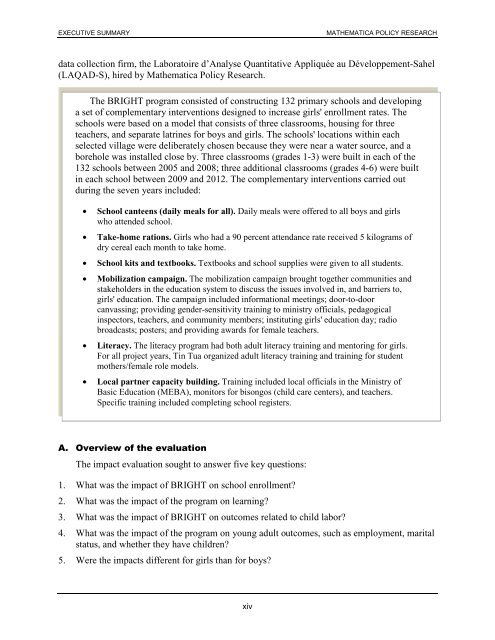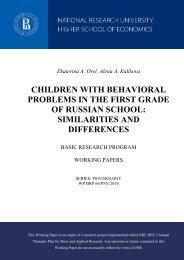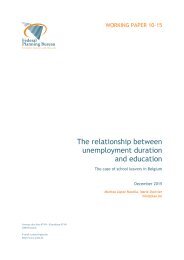Ten-Year Impacts of Burkina Faso’s BRIGHT Program
n?u=RePEc:mpr:mprres:2ecdd42bb503422b802ce20da2bf64b7&r=edu
n?u=RePEc:mpr:mprres:2ecdd42bb503422b802ce20da2bf64b7&r=edu
Create successful ePaper yourself
Turn your PDF publications into a flip-book with our unique Google optimized e-Paper software.
EXECUTIVE SUMMARY<br />
MATHEMATICA POLICY RESEARCH<br />
data collection firm, the Laboratoire d’Analyse Quantitative Appliquée au Développement-Sahel<br />
(LAQAD-S), hired by Mathematica Policy Research.<br />
The <strong>BRIGHT</strong> program consisted <strong>of</strong> constructing 132 primary schools and developing<br />
a set <strong>of</strong> complementary interventions designed to increase girls' enrollment rates. The<br />
schools were based on a model that consists <strong>of</strong> three classrooms, housing for three<br />
teachers, and separate latrines for boys and girls. The schools' locations within each<br />
selected village were deliberately chosen because they were near a water source, and a<br />
borehole was installed close by. Three classrooms (grades 1-3) were built in each <strong>of</strong> the<br />
132 schools between 2005 and 2008; three additional classrooms (grades 4-6) were built<br />
in each school between 2009 and 2012. The complementary interventions carried out<br />
during the seven years included:<br />
• School canteens (daily meals for all). Daily meals were <strong>of</strong>fered to all boys and girls<br />
who attended school.<br />
• Take-home rations. Girls who had a 90 percent attendance rate received 5 kilograms <strong>of</strong><br />
dry cereal each month to take home.<br />
• School kits and textbooks. Textbooks and school supplies were given to all students.<br />
• Mobilization campaign. The mobilization campaign brought together communities and<br />
stakeholders in the education system to discuss the issues involved in, and barriers to,<br />
girls' education. The campaign included informational meetings; door-to-door<br />
canvassing; providing gender-sensitivity training to ministry <strong>of</strong>ficials, pedagogical<br />
inspectors, teachers, and community members; instituting girls' education day; radio<br />
broadcasts; posters; and providing awards for female teachers.<br />
• Literacy. The literacy program had both adult literacy training and mentoring for girls.<br />
For all project years, Tin Tua organized adult literacy training and training for student<br />
mothers/female role models.<br />
• Local partner capacity building. Training included local <strong>of</strong>ficials in the Ministry <strong>of</strong><br />
Basic Education (MEBA), monitors for bisongos (child care centers), and teachers.<br />
Specific training included completing school registers.<br />
A. Overview <strong>of</strong> the evaluation<br />
The impact evaluation sought to answer five key questions:<br />
1. What was the impact <strong>of</strong> <strong>BRIGHT</strong> on school enrollment?<br />
2. What was the impact <strong>of</strong> the program on learning?<br />
3. What was the impact <strong>of</strong> <strong>BRIGHT</strong> on outcomes related to child labor?<br />
4. What was the impact <strong>of</strong> the program on young adult outcomes, such as employment, marital<br />
status, and whether they have children?<br />
5. Were the impacts different for girls than for boys?<br />
xiv







